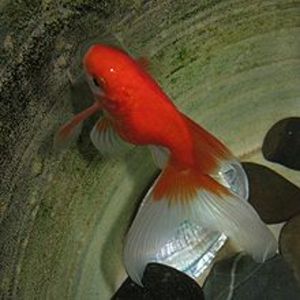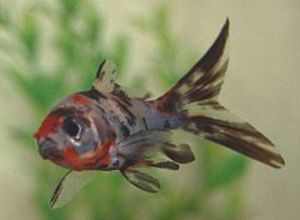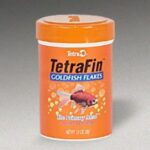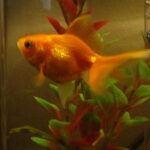Fantail goldfish are about the hardiest of fancy goldfish. Although they have an egg-shaped body and longer fins than a common goldfish, they are not encumbered by extreme facial and fin features that can impair the swimming abilities of other types of fancy goldfish. It is speculated that the fantail was the first egg-shaped fancy goldfish developed in the Orient.
Suitable Tank Mates
But fantail goldfish should not be kept with faster swimming torpedo-shaped goldfish like shubunkins, comet or common goldfish. Although some fantails can hold their own in getting enough food, often the torpedo-shaped goldfish will just be so fast and so mobile that they suck down all of the food, leaving the fantail to starve.
Fantails can be kept with black moors, pandas, butterflies, pearlscales that lack excessive fin length and some Ryukins (depending on the size and health of the individual Ryukin.) Some people have also kept cold water minnows with them. Snails will not bother the goldfish, but they reproduce so rapidly that they should be avoided.
Size
Fantail goldfish can grow to be ten inches (25 cm) long, although these are exceptional. The average fantail only grows to about four to six inches in length. But their size should be kept in mind when deciding to bring a fantail home. Fantails sold in pet stores are often juveniles and so look small and cute.
You are going to need an aquarium that is at least 20 gallons large, preferably more, for just three fantails. Never keep fantails in bowls, unless they are being transported somewhere or judged in shows. They need an aquarium with a filter and a heater to thrive. They do best with a more or less constant water temperature range of 55 to 70 degrees F.
That Tail
Fantails have an egg-shaped body with their heads at the “pointy” end. Their tails ideally should be fully split so that they have two tails. However, many fantails do not possess two full tails but one tail that has a smaller twin attached or has a tail split only at the top and not at the bottom.
Unless you are showing the goldfish at a fish show, you do not have to worry about the tail. Fantails can swim quite well, even with less than ideal tails. The tail varies in length but often is about as long as the body. It’s good to become familiar with the tail’s length and appearance in order to catch the first signs of injury or illness.
Colors
Fantails come in just about as many colors and color patterns as common and comet goldfish. These include all orange, red and white, black and canary yellow, black and gold, calico and a blackish-bronze. Their scales come in three different types – regular matte, metallic and a speckled type called nacreous.
Goldfish often change colors throughout their lives, so do not pick a juvenile goldfish strictly on the basis of color. Color can change. It is far more important to bring home a healthy fish than a pretty fish.
References
“Goldfish: A Pet Owner’s Manual.” Marshall Ostrow. Barron’s; 1995.
“Goldfish.” Bernice Brewster and Nick Fletcher.” Bow Tie Press; 2004.
American Goldfish Association. “Finnage in Goldfish.” http://www.americangoldfish.org/Articles/Finnage%20in%20Goldfish.pdf
Animal World. “Fantail Godlfish.” http://animal-world.com/encyclo/fresh/goldfish/FantailGoldfish.php





